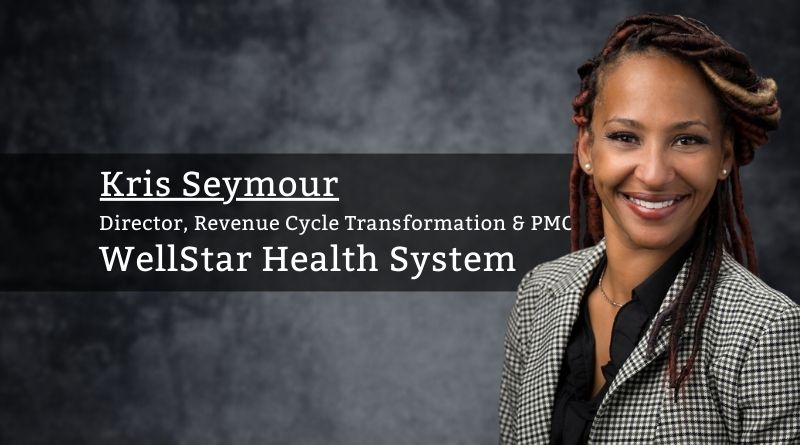Navigating the Automation Maze: Revolutionizing Revenue Cycle Management (RCM)
By Kris Seymour, Director, Revenue Cycle Transformation and PMO, WellStar Health System
In the ever-evolving healthcare landscape, RCM stands as a critical aspect that ensures financial stability for healthcare providers. However, the journey of optimizing revenue cycles is fraught with challenges, and one of the most pressing concerns is the need for automation.
The Need for Automation in RCM
The healthcare industry has recognized the urgency of embracing automation to enhance efficiency, reduce errors and address other day-to-day challenges. However, the path to automation is often obscured by a lack of clarity on where to start. The myriad of options, from optimizing EMR to implementing third-party vendor solutions, can be overwhelming. Additionally, the definition of automation varies depending on who you speak with, adding to the confusion.
Value of Automation
Automation, in the context of RCM, employs technology to streamline and optimize financial processes, minimize manual intervention, reduce errors, and enhance overall operational efficiency. This transformative force in RCM delivers benefits, enhancing efficiency by streamlining workflows, reducing processing time, and optimizing resource utilization.
Additionally, it significantly minimizes billing, coding, and claims processing errors, ensuring precision and reliability in financial processes. Cost savings are a notable advantage as automation eliminates manual handling of repetitive tasks, freeing up resources that can be redirected to critical areas within healthcare. Moreover, automation plays a vital role in ensuring compliance with industry regulations and mitigating the risk of non-compliance and associated financial penalties.
The positive impact of automation extends further, expediting claims processing and billing for faster reimbursement, making it a multifaceted solution that improves efficiency, accuracy, cost-effectiveness, regulatory adherence, and overall patient satisfaction in RCM.
By integrating automation, we embark on a transformative journey that optimizes processes, empowers our people, and enhances the overall quality of care for our patients.
Key Questions Before Approaching Automation
Before venturing into the realm of automation in healthcare RCM, it’s imperative to delve into the existing processes. Understanding the nuances of the current revenue cycle procedures is the foundational step. This involves thoroughly assessing how automation can strategically optimize these existing processes. By identifying bottlenecks and areas for improvement, organizations ensure that automation is applied judiciously for maximum impact.
Moving beyond mere budget considerations, evaluating the ROI becomes paramount. How automation will influence the broader business landscape, encompassing efficiency, cost-effectiveness, and overall performance, forms a critical facet of the pre-implementation assessment. This holistic understanding ensures that the introduction of automation aligns seamlessly with the organization’s overarching business objectives.
Integration with existing systems and scalability are intertwined considerations. Organizations need to evaluate whether automation can effortlessly integrate into the current system or if there’s a necessity for integration with a new system. This assessment encompasses both scalability and the potential impact on existing workflows. Deciding whether to add automation within an existing system or integrate a new one becomes pivotal to ensure a smooth transition without disruption.
Furthermore, it’s essential to consider the impact on end-users. Will automation simplify their tasks or make their jobs more complex? Striking the right balance is key to ensuring that automation enhances the user experience rather than causing unnecessary complications. This user-centric perspective is crucial for the successful implementation and acceptance of automation within the healthcare revenue cycle.
Some Lessons Learned when Implementing Automation
Learning from the lessons of organizations that have successfully implemented automation in Healthcare RCM reveals valuable insights for those considering a similar path. These lessons underscore key considerations.
Automation does not have to be an all-or-nothing scenario. Starting small and gradually scaling has proven to be a successful approach. Many organizations initiate their automation endeavors with pilot projects targeting specific processes. This allows them to cautiously test the waters, identify challenges, and refine their approach before expanding the scope.
Collaboration with stakeholders, especially frontline staff, is paramount. Involving key personnel in the decision-making process fosters a sense of ownership and ensures that the chosen automation solution aligns seamlessly with organizational goals and day-to-day workflows. Input from those directly involved in operations is instrumental for a smooth transition.
Know that automation is not a one-and-done solution. Successful organizations emphasize continuous monitoring and optimization because automation is not a one-time fix. Regular reassessment of the effectiveness of automation ensures adaptability to evolving challenges, maintaining agility in response to dynamic healthcare landscapes.
Flexibility and adaptability are cornerstones of effective automation strategies. Acknowledging the dynamic nature of the healthcare industry, organizations that thrive in automation embrace solutions capable of evolving with changes in regulations, technology, and organizational growth.
Contrary to common assumptions, the impact on staffing, measured in Full-Time Equivalents (FTEs), is nuanced. While automation can free up staff from mundane tasks, its implementation does not always equate to reducing FTEs. Acknowledging this, organizations recognize that automating a broken process may expose a need for more FTEs if underlying issues are not addressed. Automating a flawed system is akin to masking a problem rather than solving it, highlighting the importance of thorough evaluation before implementation.
Lastly, the overarching lesson emphasizes the necessity to evaluate existing processes before introducing automation. Adding automation to a broken or inefficient process is not a panacea. A critical evaluation of workflows is essential, identifying areas that need improvement. Automation should strategically enhance well-defined and optimized processes, contributing positively to the overall efficiency and effectiveness of healthcare RCM.
Taking steps toward implementing automation in RCM is marked by challenges, uncertainties, and the need for careful consideration. By defining automation, understanding its value, asking critical questions, and drawing insights from successful implementations in other organizations, healthcare providers can navigate this complex landscape with confidence.
As the healthcare industry continues to embrace automation, there is hope for a future where revenue cycle processes are more efficient, accurate, and the evolving needs of patients and providers alike. Embracing these challenges of automation as opportunities for growth and improvement will undoubtedly pave the way for a more streamlined and resilient healthcare system. By integrating automation, we embark on a transformative journey that optimizes processes, empowers our people, and enhances the overall quality of care for our patients.



